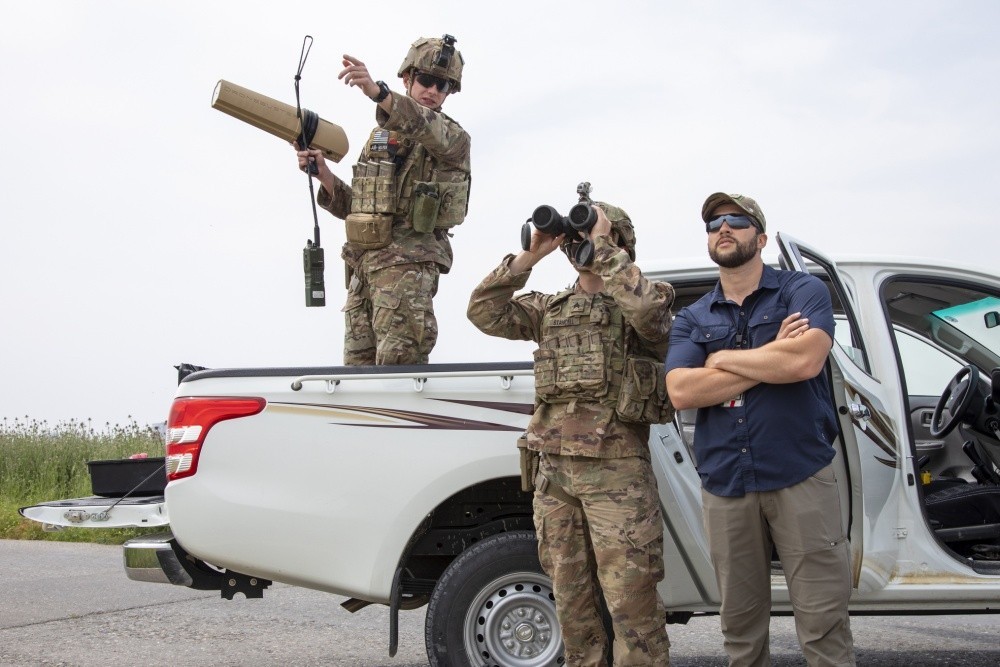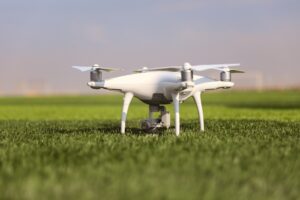
The Army conducted counter-drone training in Iraq in April 2020.
WASHINGTON: The Pentagon will choose a first round of industry-developed systems for shooting down small drones in early 2022, according to officials at the the Joint Counter-small Unmanned Aerial Systems Office (JCO).
That initial set of capabilities is known as “Low-Collateral Effects Increment No. 1,” JCO Director Army Major Gen. Sean Gainey told reporters in a briefing today. The plan is to figure out what industry has “ready to deliver; ready to get it out to the field, pretty quickly.”
The term “low-collateral effects” refers to counter drone systems that can be employed with few negative consequences for non-enemy aircraft and electronic systems near the field of intercept. Those types of weapons are the first focus in implementing DoD’s strategy to defeat small drones, released in early January.

Maj. Gen. Sean Gainey
“JCO conducted an assessment of all the affiliated counter-UAS capabilities [within DoD] and essentially determined the selection of the current systems for future investment, based on a criteria such as effectiveness usability sustainment and the integration –and that was one of our focuses, integration — into a common C2 [command and control system],” Gainey elaborated. “With that assessment now complete … we’re now continuing to work with industry to really bring these interim systems to full maturity, or to eventually replace them with follow-on, enduring solutions, and we’ve reached out to industry to help us move forward.”
While Gainey didn’t directly answer a question about whether any system would be available by Sept. 30, as mandated in the 2021 National Defense Authorization Act (NDAA), the timeframe provided by JCO officials suggests the answer is ‘no.’
Army Col. Greg Soulé, JCO director of acquisition & resources, said the office is reviewing industry proposals sent in response to a Jan. 22 request for information (RFI). The focus of these first trials, to be held in April at the Yuma Proving Ground, is on “low-collateral effects interceptors,” he said. The RFI explains: “Specific, but not limited, uses would include defeating small UAS in urban environments, over sensitive sites, or situations where the rules of engagement would not allow kinetic effects.”
Soulé says they’ll pick a down-select group to provide oral presentations, and then decide who comes to the trials. Based on the results — and “working with the Air Force as the designated service lead for this capability area” — the JCO will “compare [chosen systems] against other similar low-collateral effect interceptor solutions that are already under government contract” and assess their add-on value. “[L]ate ’21, I believe, is the current Air Force plan” for finishing that review, he said. “And then, in the ’22 timeframe, selecting that initial capability for procurement and fielding to the force.”
The Air Force, and the Army’s Rapid Capabilities & Critical Technologies Office (RCCTO), which leads ground-force development of cutting-edge tech like high-powered lasers and hypersonic missiles, are partners with the JCO in the C-sUAS endeavor.
The April trials are only a first. There will be follow-on industry solicitations and trials for other types of low-collateral damage weapons, specifically those based on directed-energy, the JCO officials said.
There will certainly be “follow-on efforts … to look at the next set of solutions and/or payloads that would also be a part of this low-collateral effects interceptor package,” Soulé said.

A small drone used in Army C-sUAS training.
The end goal is a “system of systems, including kinetic; high-energy lasers being tested in field right now; and, eventually, high-powered microwaves,” Gainey said. “We’re deploying those [laser] systems right now, under combat into theaters right now, and seeing a lot of progress with high-energy lasers. Also, simultaneously, we’re working — as most of you probably know — through the Air Force work in high-powered microwave capability that will also be deployed pretty soon. So those two capabilities — which although they’re designed as components into architecture, can potentially become inherent systems themselves — are being tested.”
The Air Force plans to do field testing on its Tactical High Power Microwave Operational Responder (THOR). It was expected to be deployed to Africa last fall but that was delayed by the COVID-19 pandemic. While there was some kerfluffle late last year about whether THOR had already been fielded, the bottom line is that THOR will be deployed sometime in 2021.
As various C-sUAS systems are deployed, Gainey stressed that integrated C2 is key to ensuring cross-service functionality, and that they can plug and play with the future Joint All-Domain Command and Control (JADC2) system, as well as the “common data language” being developed by the University of California for DoD’s Research & Engineering office (OSDR&E).
“When we first started off, we recognized command and control was going to be the center of gravity for interoperability. And that’s really what we’re driving to right now is interoperability” of the three C2 systems endorsed by the JCO back in June:
- FAAD-C2 (Forward Area Air Defense Command and Control), developed by Northrop Grumman for the Army but now used by the Marines, Air Force, and Special Operations as well.
- MEDUSA (Multi-Environmental Domain Unmanned Systems Application Command and Control), developed by Kongsberg for the Air Force.
- ADSI (Air Defense System Integrator), developed for the Marines by Ultra Group.
“We’re sitting at a good spot in establishing that [interoperability] up front earlier, so now industry is building components to our common c2 standard,” Gainey said.
Connecticut lawmakers to grill Army, Lockheed about job cuts at Sikorsky helicopter unit
“The Connecticut delegation has questions about why, with that [FY24] appropriation in hand, this happened,” said Rep. Joe Courtney, D-Conn.


























